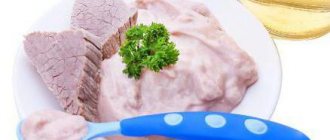Parents often ask their pediatrician: at what age can a child be given cheese and what kind of reaction should be expected. The product has obvious advantages: it is tasty, healthy and inexpensive. The most dangerous drawback is the possibility of intolerance. Babies have allergic reactions to dairy products, which means they need to be given lactose-free complementary foods.
Beneficial properties of cheese for children's bodies
To understand from how many months you can give your baby cheese, you need to know about its beneficial properties. In general, dairy and fermented milk products appear in a child’s diet after one year. As a rule, these are cottage cheese and kefir.
Dairy products contain calcium, which takes part in the formation of the skeleton and its strengthening, protein - a building material for body cells, and other substances.
Early introduction of dairy products into the diet goes without problems and contributes to the formation of taste habits. It is much more difficult to feed a child something new for the first time at 7-8 years old.
Not every mother gives cheese to her one-year-old baby, but everyone feeds him with baby curds, yoghurts, and milk porridges. However, the benefits of cheese are incomparable.
So, the nutrient content of different types of cheese varies slightly, but on average it is as follows:
- 20-25% - proteins;
- calcium;
- phosphorus;
- vitamins of all groups.
The benefits of cheese for children's bodies are as follows:
- calcium is involved in strengthening bone tissue and teeth, hair and nails;
- protein is involved in tissue formation;
- uniform weight gain occurs;
- thanks to the fats, cheese makes it easy to quickly fill up and recharge with energy;
- gives a correct idea of taste habits;
- fatty acids are an essential trace element for the full formation of all organs and tissues;
- promotes the development of visual acuity.
The conclusion is this: after a year, cheese should become a mandatory product on a child’s menu. And its caloric content should not worry the mother, because the baby is so active that he uses up everything he consumed.
Tips for parents
The rules for introducing new foods into a baby’s diet are the same. When you decide to introduce your child to cheese, follow these simple tips:
- Offer only one new food per day, prepare the rest of the food as usual using everyday ingredients;
- Treat your baby to a microdose of cheese the size of a pea;
- introduce a new product in the first half of the day, when digestive enzymes are released more intensely;
- monitor the reaction throughout the day;
- repeat the steps for 5 days;
- if there is no negative reaction, increase the amount of the product and include it in your diet on an ongoing basis;
- in case of negative consequences, postpone the introduction of cheese into the diet for at least 3 months;
- if the salt content in the cheese is high, soak it in cold water for several hours;
- When your baby refuses to eat a piece of cheese, use a grater.
How often can you give cheese?
It is safer for a child’s body to give this fermented milk product no more than three times a week. It is introduced into daily nutrition as the digestive and enzymatic system grows and matures - by 2.5-3 years.
Permitted quantity
Cheese is not a product that is usually consumed in large quantities. And when it comes to kids, the weight of this dish does not exceed several tens of grams:
- one-year-old children are treated starting with microdoses and gradually increasing the portion to 5 g per day;
- by 1.5 years, the weight of the piece is increased to 10-15 g;
- at 2 years it is safe to offer 20 g;
- By the age of 3, a slice weighing up to 30 g is cut off.
In what forms should it be given and with what can it be combined?
Cheese is a universal food, good both as an independent product and as a component of complex dishes. For children of the second year of life, it is preferable to add grated cheese as an additional ingredient to:
- omelettes;
- soups;
- casseroles;
- vegetable dishes;
- pasta.
To avoid harming your child’s body, follow these simple rules:
- Do not offer children under 3 years of age cheese along with fatty, protein-rich and salty foods to avoid disruptions in the functioning of the organs and systems of the developing body;
- do not combine fermented milk products with meat dishes as a preventive measure for iron deficiency anemia, because calcium interferes with the absorption of iron;
- Only after reaching 3 years of age should you treat your children to a sandwich with cheese; from the same age it is acceptable to eat it with butter.
What kind of cheese can a 1 year old child eat?
When choosing cheese for a one-year-old child, you need to immediately move away from the shelves with smoked, processed and pickled varieties. Their main drawback is the excess salt and fat in the composition. In general, salt should be present in minimal quantities in a baby’s diet. You can only determine how salty a cheese is by experiment. And in the store you need to check that it has a natural color. The presence of dyes makes the color of the product too bright. Fat content should not exceed 20% of the total composition.
The most useful varieties for a child are “Maasdam”, “Russian”, “Poshekhonsky”.
Curd cheeses can be given to babies only if they do not contain flavorings or preservatives with index E. It turns out that giving regular cottage cheese is healthier than curd cheese. In general, the production of a processed product uses raw materials with an expiring shelf life, therefore, processed cheeses are contraindicated for children.
It is not recommended to give blue cheeses to children, but it is not strictly prohibited as smoked cheeses. A seven-year-old child, for example, can already be given them. The downside of this variety is the high likelihood of allergic reactions.
The very first type of cheese for a child can be “Maasdam”. Its sweetish taste will not repel the baby, and its soft consistency is good for a child when he is just learning to chew.
At what age can you give
Even hard, low-fat varieties, without additives, are not recommended by pediatricians to be given to children under one year of age. Until this age, the child’s kidneys are not yet able to cope with the large amount of minerals and salt in the product.
A fatty product can cause stool upset in young children; it is also difficult for the baby’s body to cope with excess protein.
If you introduce cheese into your diet too early, an allergy may develop. After a year, this risk is reduced several times, since with age the baby’s intestinal walls become more resistant to the penetration of allergens, and the immune system is strengthened.
It is worth delaying introduction to dairy products until two years of age if the baby has a pronounced allergy to any dairy products or regular bowel movements. Children with milk protein intolerance can be offered special lactose-free varieties of cheese. Their peculiarity is that they are most often quite salty. Before use, it is recommended to soak it in cold water for at least three hours.
In what quantities and in what form should I give my baby cheese?
You can give your baby cheese cut into small slices, as they say, for one tooth. This way he can chew it. If the child is not impressed with this product and he spits it out, you can grate it on a fine grater and mix it with other foods, including grated vegetables or an apple. You should not include cheese in the menu more than 3 times a week.
A three-year-old child can already eat 10 g of this healthy product in the form of a sandwich in the company of bread and butter. You can also grate it and add it to soups, salads, vegetable purees, or sprinkle it over pasta.
Benefit
Cheese, when consumed correctly, will bring many benefits to your child:
- Cheese is a supplier of valuable amino acids, containing the entire set of essential amino acids, which is especially important for a growing child’s body.
- The mineral composition will ensure strong bones, tooth enamel, and healthy hair.
- Fatty acids are necessary for the normal functioning of the brain and to ensure healthy skin.
- Thanks to the antioxidant properties of vitamins E and A, the body is cleansed of toxic substances and radionuclides. Vitamins also help improve general and local immunity.
- Eating cheese will satisfy hunger, give a quick feeling of fullness, and serve as a boost of energy for the child.
- Chewing hard cheese will contribute to the proper development of the jaw apparatus.
- Considering the almost complete digestibility of nutrients, the product is useful for.
- Hard cheeses can be consumed by children with age, since during the manufacturing process the product almost completely gets rid of lactose (milk sugar).
- The introduction of cheese into the diet makes it possible to diversify a child’s menu and expand his taste sensations.
How to choose healthy cheese?
You should immediately stop buying a product in vacuum packaging. It probably doesn't taste very good. We also ignore a product that is sold at a significant discount. The main reason for such price reductions is the close expiration date. The second reason is that the manufacturer makes the product cheaper due to low-quality raw materials and inedible additives. The baby’s reaction to the taste of such cheese is predictable: complete rejection of this product and aversion to it for life.
It is best to go to the market for quality cheese from a reputable seller or to a supermarket that enjoys a positive reputation among the population. It is preferable to choose a product that is cut from a whole circle in front of the buyer’s eyes. When purchasing cheese in a package, you need to check whether it says on it that it is a cheese product. It contains many artificial additives and little benefit.
How to test cheese for digestibility
High-quality cheese will not harm a child, many parents think so. In fact, it may not be absorbed by the baby’s body. To check this, you need to test this product. On the day of testing, there should be no new products on the child’s menu except cheese.
The first piece should be tiny, no more than a slice of chocolate. It is better to grate it and feed it to the baby with a spoon. If he winces and in every possible way
shows dissatisfaction with the taste of cheese, you should not feed it all. If you like the new product, it’s still enough for the first time.
Now you need to look to see if the baby has developed a skin allergy, if he is crying, as happens with abdominal pain, or if he has diarrhea. If the result is completely positive, you can give cheese 2-4 times a week, testing all new varieties approved for baby food. Accordingly, if problems arise, it is better to abandon the new experiment for now.
Allergy to cheese in children: causes and signs
A serious and, in most cases, lifelong disease is dairy intolerance. An allergic reaction can be caused by certain varieties or all cheese products. The reaction occurs to lactose or casein. If you are intolerant to certain compounds, the allergy occurs suddenly and is accompanied by severe symptoms.
The reaction occurs immediately after consuming the allergen - in most cases. Milk-containing foods, even after careful processing, are harmful to a baby with intolerance.
In such a case, parents should choose cheese based on plant-based milk for their baby. If the delicacy is fermented by hand, it will not harm the body. Many lactose-free products taste no different from milk-containing ones.
Tofu is suitable for children and adults with problems digesting lactose. Soy milk replaces cow's milk and contains a large amount of nutrients. There are a lot of worthy replacement options.
The disease often occurs at an early age. The child's body is not yet formed and therefore immediately reacts to any irritants. The reaction most often occurs to milk, but it also happens to food additives and preservatives.
The main cause of allergies is intolerance. General symptoms:
- Painful sensations in the abdomen.
- Diarrhea or constipation.
- Allergic reactions. The appearance of blisters or pinpoint rashes.
- Asthma attacks.
- Swelling on the face, puffiness.
- Increase in body temperature. The body quickly reacts to the allergen and the inflammatory process starts.
Another sign of an allergy is the release of mucus from the nasopharynx. In a child, the reaction is more acute than in an adult. Sometimes signs of lactose intolerance include shortness of breath and anaphylaxis.
Most often, a rash is caused by a moldy product. The child's body produces immunoglobulin, which is why rashes appear on the skin. Another symptom of a cheese allergy is a severe coughing attack.
If any negative manifestations occur after eating cheese, parents should consult a doctor. There are tests for lactose intolerance. In order not to worry about the presence of the disease, it is better to undergo an examination and create a healthy and safe menu.











